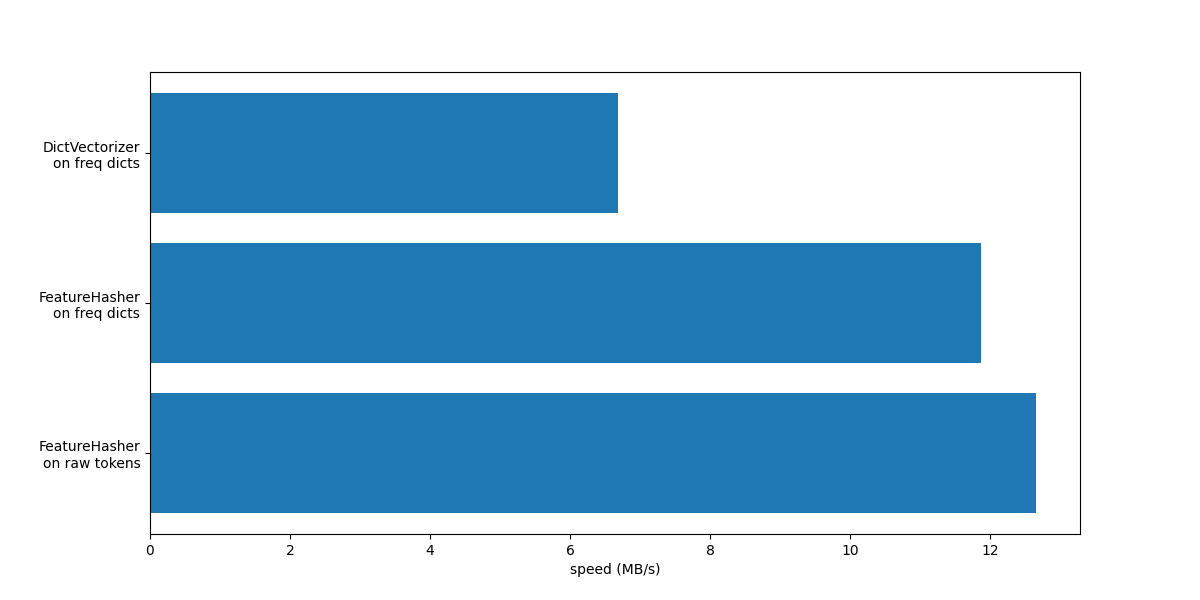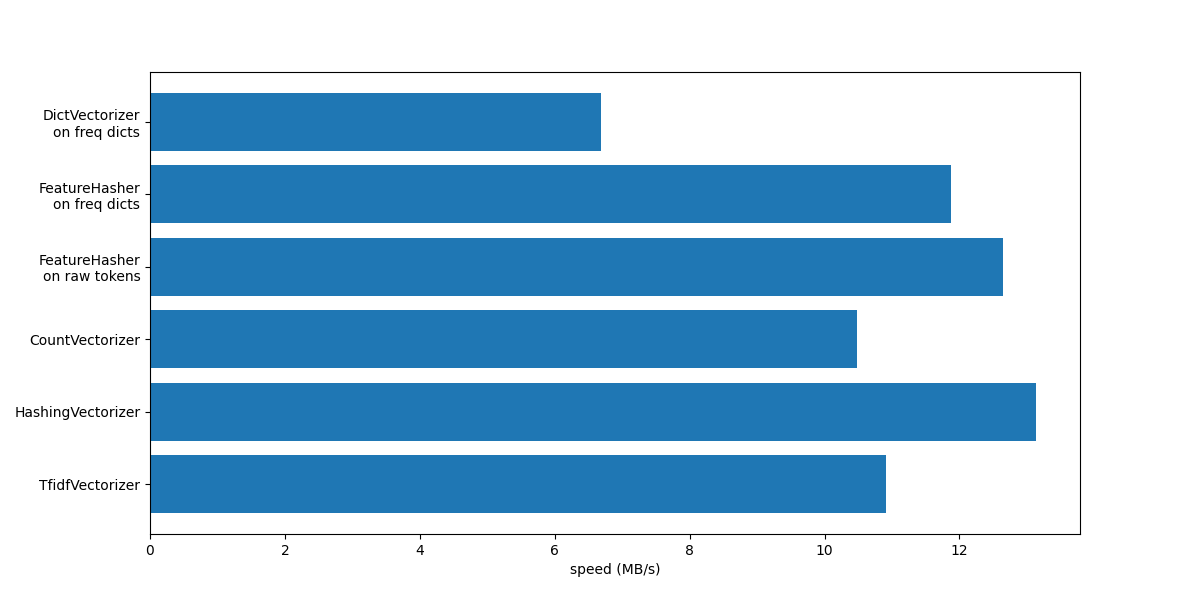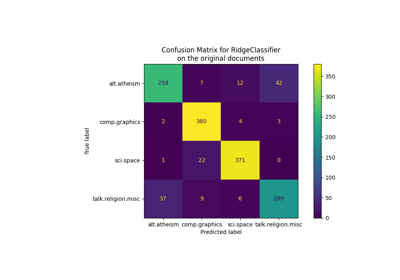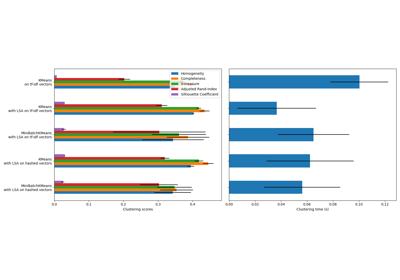Note
Go to the end to download the full example code. or to run this example in your browser via Binder
FeatureHasher and DictVectorizer Comparison#
In this example we illustrate text vectorization, which is the process of representing non-numerical input data (such as dictionaries or text documents) as vectors of real numbers.
We first compare FeatureHasher and
DictVectorizer by using both methods to
vectorize text documents that are preprocessed (tokenized) with the help of a
custom Python function.
Later we introduce and analyze the text-specific vectorizers
HashingVectorizer,
CountVectorizer and
TfidfVectorizer that handle both the
tokenization and the assembling of the feature matrix within a single class.
The objective of the example is to demonstrate the usage of text vectorization API and to compare their processing time. See the example scripts Classification of text documents using sparse features and Clustering text documents using k-means for actual learning on text documents.
# Authors: The scikit-learn developers
# SPDX-License-Identifier: BSD-3-Clause
Load Data#
We load data from The 20 newsgroups text dataset, which comprises around 18000 newsgroups posts on 20 topics split in two subsets: one for training and one for testing. For the sake of simplicity and reducing the computational cost, we select a subset of 7 topics and use the training set only.
from sklearn.datasets import fetch_20newsgroups
categories = [
"alt.atheism",
"comp.graphics",
"comp.sys.ibm.pc.hardware",
"misc.forsale",
"rec.autos",
"sci.space",
"talk.religion.misc",
]
print("Loading 20 newsgroups training data")
raw_data, _ = fetch_20newsgroups(subset="train", categories=categories, return_X_y=True)
data_size_mb = sum(len(s.encode("utf-8")) for s in raw_data) / 1e6
print(f"{len(raw_data)} documents - {data_size_mb:.3f}MB")
Loading 20 newsgroups training data
3803 documents - 6.245MB
Define preprocessing functions#
A token may be a word, part of a word or anything comprised between spaces or symbols in a string. Here we define a function that extracts the tokens using a simple regular expression (regex) that matches Unicode word characters. This includes most characters that can be part of a word in any language, as well as numbers and the underscore:
import re
def tokenize(doc):
"""Extract tokens from doc.
This uses a simple regex that matches word characters to break strings
into tokens. For a more principled approach, see CountVectorizer or
TfidfVectorizer.
"""
return (tok.lower() for tok in re.findall(r"\w+", doc))
list(tokenize("This is a simple example, isn't it?"))
['this', 'is', 'a', 'simple', 'example', 'isn', 't', 'it']
We define an additional function that counts the (frequency of) occurrence of each token in a given document. It returns a frequency dictionary to be used by the vectorizers.
from collections import defaultdict
def token_freqs(doc):
"""Extract a dict mapping tokens from doc to their occurrences."""
freq = defaultdict(int)
for tok in tokenize(doc):
freq[tok] += 1
return freq
token_freqs("That is one example, but this is another one")
defaultdict(<class 'int'>, {'that': 1, 'is': 2, 'one': 2, 'example': 1, 'but': 1, 'this': 1, 'another': 1})
Observe in particular that the repeated token "is" is counted twice for
instance.
Breaking a text document into word tokens, potentially losing the order information between the words in a sentence is often called a Bag of Words representation.
DictVectorizer#
First we benchmark the DictVectorizer,
then we compare it to FeatureHasher as
both of them receive dictionaries as input.
from time import time
from sklearn.feature_extraction import DictVectorizer
dict_count_vectorizers = defaultdict(list)
t0 = time()
vectorizer = DictVectorizer()
vectorizer.fit_transform(token_freqs(d) for d in raw_data)
duration = time() - t0
dict_count_vectorizers["vectorizer"].append(
vectorizer.__class__.__name__ + "\non freq dicts"
)
dict_count_vectorizers["speed"].append(data_size_mb / duration)
print(f"done in {duration:.3f} s at {data_size_mb / duration:.1f} MB/s")
print(f"Found {len(vectorizer.get_feature_names_out())} unique terms")
done in 0.892 s at 7.0 MB/s
Found 47928 unique terms
The actual mapping from text token to column index is explicitly stored in
the .vocabulary_ attribute which is a potentially very large Python
dictionary:
type(vectorizer.vocabulary_)
len(vectorizer.vocabulary_)
47928
vectorizer.vocabulary_["example"]
19145
FeatureHasher#
Dictionaries take up a large amount of storage space and grow in size as the
training set grows. Instead of growing the vectors along with a dictionary,
feature hashing builds a vector of pre-defined length by applying a hash
function h to the features (e.g., tokens), then using the hash values
directly as feature indices and updating the resulting vector at those
indices. When the feature space is not large enough, hashing functions tend to
map distinct values to the same hash code (hash collisions). As a result, it
is impossible to determine what object generated any particular hash code.
Because of the above it is impossible to recover the original tokens from the feature matrix and the best approach to estimate the number of unique terms in the original dictionary is to count the number of active columns in the encoded feature matrix. For such a purpose we define the following function:
import numpy as np
def n_nonzero_columns(X):
"""Number of columns with at least one non-zero value in a CSR matrix.
This is useful to count the number of features columns that are effectively
active when using the FeatureHasher.
"""
return len(np.unique(X.nonzero()[1]))
The default number of features for the
FeatureHasher is 2**20. Here we set
n_features = 2**18 to illustrate hash collisions.
FeatureHasher on frequency dictionaries
from sklearn.feature_extraction import FeatureHasher
t0 = time()
hasher = FeatureHasher(n_features=2**18)
X = hasher.transform(token_freqs(d) for d in raw_data)
duration = time() - t0
dict_count_vectorizers["vectorizer"].append(
hasher.__class__.__name__ + "\non freq dicts"
)
dict_count_vectorizers["speed"].append(data_size_mb / duration)
print(f"done in {duration:.3f} s at {data_size_mb / duration:.1f} MB/s")
print(f"Found {n_nonzero_columns(X)} unique tokens")
done in 0.493 s at 12.7 MB/s
Found 43873 unique tokens
The number of unique tokens when using the
FeatureHasher is lower than those obtained
using the DictVectorizer. This is due to
hash collisions.
The number of collisions can be reduced by increasing the feature space. Notice that the speed of the vectorizer does not change significantly when setting a large number of features, though it causes larger coefficient dimensions and then requires more memory usage to store them, even if a majority of them is inactive.
t0 = time()
hasher = FeatureHasher(n_features=2**22)
X = hasher.transform(token_freqs(d) for d in raw_data)
duration = time() - t0
print(f"done in {duration:.3f} s at {data_size_mb / duration:.1f} MB/s")
print(f"Found {n_nonzero_columns(X)} unique tokens")
done in 0.493 s at 12.7 MB/s
Found 47668 unique tokens
We confirm that the number of unique tokens gets closer to the number of
unique terms found by the DictVectorizer.
FeatureHasher on raw tokens
Alternatively, one can set input_type="string" in the
FeatureHasher to vectorize the strings
output directly from the customized tokenize function. This is equivalent to
passing a dictionary with an implied frequency of 1 for each feature name.
t0 = time()
hasher = FeatureHasher(n_features=2**18, input_type="string")
X = hasher.transform(tokenize(d) for d in raw_data)
duration = time() - t0
dict_count_vectorizers["vectorizer"].append(
hasher.__class__.__name__ + "\non raw tokens"
)
dict_count_vectorizers["speed"].append(data_size_mb / duration)
print(f"done in {duration:.3f} s at {data_size_mb / duration:.1f} MB/s")
print(f"Found {n_nonzero_columns(X)} unique tokens")
done in 0.479 s at 13.0 MB/s
Found 43873 unique tokens
We now plot the speed of the above methods for vectorizing.
import matplotlib.pyplot as plt
fig, ax = plt.subplots(figsize=(12, 6))
y_pos = np.arange(len(dict_count_vectorizers["vectorizer"]))
ax.barh(y_pos, dict_count_vectorizers["speed"], align="center")
ax.set_yticks(y_pos)
ax.set_yticklabels(dict_count_vectorizers["vectorizer"])
ax.invert_yaxis()
_ = ax.set_xlabel("speed (MB/s)")

In both cases FeatureHasher is
approximately twice as fast as
DictVectorizer. This is handy when dealing
with large amounts of data, with the downside of losing the invertibility of
the transformation, which in turn makes the interpretation of a model a more
complex task.
The FeatureHeasher with input_type="string" is slightly faster than the
variant that works on frequency dict because it does not count repeated
tokens: each token is implicitly counted once, even if it was repeated.
Depending on the downstream machine learning task, it can be a limitation or
not.
Comparison with special purpose text vectorizers#
CountVectorizer accepts raw data as
it internally implements tokenization and occurrence counting. It is similar
to the DictVectorizer when used along with
the customized function token_freqs as done in the previous section. The
difference being that CountVectorizer
is more flexible. In particular it accepts various regex patterns through the
token_pattern parameter.
from sklearn.feature_extraction.text import CountVectorizer
t0 = time()
vectorizer = CountVectorizer()
vectorizer.fit_transform(raw_data)
duration = time() - t0
dict_count_vectorizers["vectorizer"].append(vectorizer.__class__.__name__)
dict_count_vectorizers["speed"].append(data_size_mb / duration)
print(f"done in {duration:.3f} s at {data_size_mb / duration:.1f} MB/s")
print(f"Found {len(vectorizer.get_feature_names_out())} unique terms")
done in 0.543 s at 11.5 MB/s
Found 47885 unique terms
We see that using the CountVectorizer
implementation is approximately twice as fast as using the
DictVectorizer along with the simple
function we defined for mapping the tokens. The reason is that
CountVectorizer is optimized by
reusing a compiled regular expression for the full training set instead of
creating one per document as done in our naive tokenize function.
Now we make a similar experiment with the
HashingVectorizer, which is
equivalent to combining the “hashing trick” implemented by the
FeatureHasher class and the text
preprocessing and tokenization of the
CountVectorizer.
from sklearn.feature_extraction.text import HashingVectorizer
t0 = time()
vectorizer = HashingVectorizer(n_features=2**18)
vectorizer.fit_transform(raw_data)
duration = time() - t0
dict_count_vectorizers["vectorizer"].append(vectorizer.__class__.__name__)
dict_count_vectorizers["speed"].append(data_size_mb / duration)
print(f"done in {duration:.3f} s at {data_size_mb / duration:.1f} MB/s")
done in 0.472 s at 13.2 MB/s
We can observe that this is the fastest text tokenization strategy so far, assuming that the downstream machine learning task can tolerate a few collisions.
TfidfVectorizer#
In a large text corpus, some words appear with higher frequency (e.g. “the”,
“a”, “is” in English) and do not carry meaningful information about the actual
contents of a document. If we were to feed the word count data directly to a
classifier, those very common terms would shadow the frequencies of rarer yet
more informative terms. In order to re-weight the count features into floating
point values suitable for usage by a classifier it is very common to use the
tf-idf transform as implemented by the
TfidfTransformer. TF stands for
“term-frequency” while “tf-idf” means term-frequency times inverse
document-frequency.
We now benchmark the TfidfVectorizer,
which is equivalent to combining the tokenization and occurrence counting of
the CountVectorizer along with the
normalizing and weighting from a
TfidfTransformer.
from sklearn.feature_extraction.text import TfidfVectorizer
t0 = time()
vectorizer = TfidfVectorizer()
vectorizer.fit_transform(raw_data)
duration = time() - t0
dict_count_vectorizers["vectorizer"].append(vectorizer.__class__.__name__)
dict_count_vectorizers["speed"].append(data_size_mb / duration)
print(f"done in {duration:.3f} s at {data_size_mb / duration:.1f} MB/s")
print(f"Found {len(vectorizer.get_feature_names_out())} unique terms")
done in 0.546 s at 11.4 MB/s
Found 47885 unique terms
Summary#
Let’s conclude this notebook by summarizing all the recorded processing speeds in a single plot:
fig, ax = plt.subplots(figsize=(12, 6))
y_pos = np.arange(len(dict_count_vectorizers["vectorizer"]))
ax.barh(y_pos, dict_count_vectorizers["speed"], align="center")
ax.set_yticks(y_pos)
ax.set_yticklabels(dict_count_vectorizers["vectorizer"])
ax.invert_yaxis()
_ = ax.set_xlabel("speed (MB/s)")

Notice from the plot that
TfidfVectorizer is slightly slower
than CountVectorizer because of the
extra operation induced by the
TfidfTransformer.
Also notice that, by setting the number of features n_features = 2**18, the
HashingVectorizer performs better
than the CountVectorizer at the
expense of inversibility of the transformation due to hash collisions.
We highlight that CountVectorizer and
HashingVectorizer perform better than
their equivalent DictVectorizer and
FeatureHasher on manually tokenized
documents since the internal tokenization step of the former vectorizers
compiles a regular expression once and then reuses it for all the documents.
Total running time of the script: (0 minutes 4.271 seconds)
Related examples

Classification of text documents using sparse features

Biclustering documents with the Spectral Co-clustering algorithm


